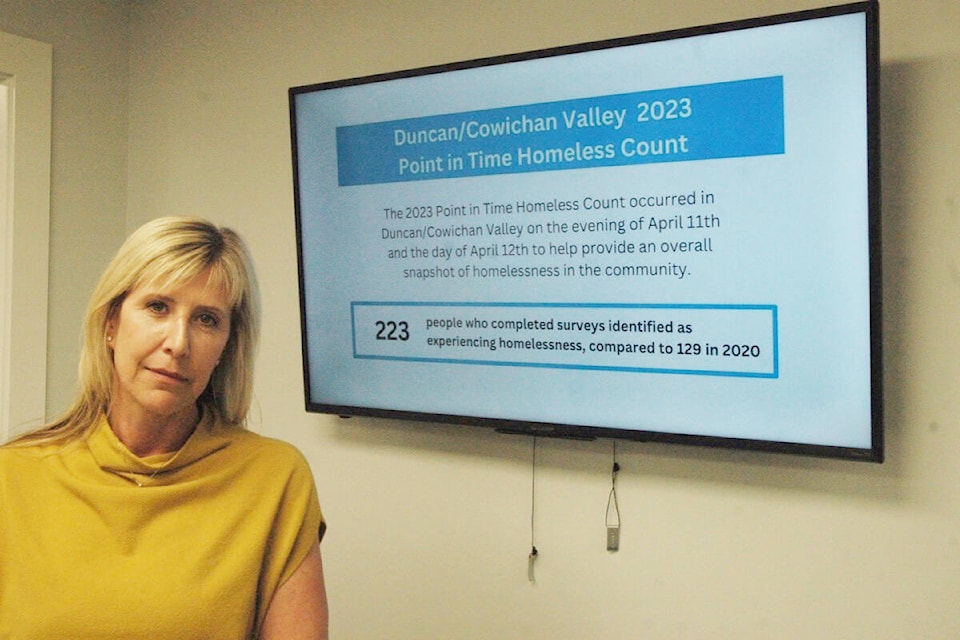The latest count of those experiencing homelessness in the Cowichan Valley indicates that there are currently 229, up considerably from the 129 that were identified in the last count in 2020.
But the organizers caution that the point-in-time count represents only those individuals identified by volunteers during a 24-hour period, from the evening of April 11 through April 12, so the numbers are understood to be the minimum number of people who are experiencing homelessness on a given day in the Valley.
Shelley Cook, executive director of the Cowichan Housing Association which facilitated the count along with United Way BC, said the organizers know they didn’t count all those experiencing homelessness in the area.
RELATED STORY: LATEST HOMELESS COUNT REVEALS 129 IN THE COWICHAN VALLEY
“There are a lot of hidden homeless who are couch surfing and sleeping in their cars, and there are many youth and members of Cowichan Tribes that are hard to get data on,” she said.
“We also didn’t count those staying at The Village [a transitional housing project on Trunk Road] and those staying at the Warmland shelter so we know there are more in the region at risk of homelessness.”
The 2023 PIT count included the whole of the Cowichan region, from Ladysmith to the Malahat.
Individuals were defined as experiencing homelessness if they did not have a place of their own where they paid rent and could expect to stay for at least 30 days.
The data collected from the count, which was funded by the federal government’s Reaching Home: Canada’s Homelessness Strategy program, is intended to help senior levels of government and communities better understand who is experiencing homelessness and why, and the count results can inform the development of supports and services that will best help people in need.
According to the data collected during the latest count, the top reasons for people currently experiencing homelessness in the Cowichan Valley are not enough income (37 per cent), substance abuse (31 per cent), conflict with landlord (22 per cent), conflict with spouse (16 per cent) and abuse (15 per cent).
RELATED STORY: NEXT COWICHAN HOMELESS COUNT TO BE HELD IN APRIL
On the evening of April 11, 54 per cent of those who were counted experiencing homelessness stayed outside, 19 per cent stayed in a tent, 11 per cent stayed in a vehicle, and 10 per cent stayed with friends or family.
The count also found that 37 per cent of those experiencing homelessness in the Cowichan Valley have always lived in the area, while 86 per cent of those who moved here have been in the community for at least one year, and 66 per cent have been in the community for at least five years.
Duncan Mayor Michelle Staples, who volunteered to assist in April’s count as well as the one held in 2020, said homelessness is a nation-wide crisis and is not an isolated issue in the Cowichan Valley.
She said homelessness can only be properly dealt with if senior levels of government are willing to commit the resources that are required.
RELATED STORY: HOMELESSNESS NO. 1 CONCERN FOR NORTH COWICHAN RESIDENTS, SURVEY FINDS
“It’s the number-one issue at the level of local governments,” Staples said.
“The information gathered during the point-in-time homeless count is what we need to take to senior levels of government and show them exactly the types of programs and initiatives that need funding so that the next time we hold a count, the number will hopefully be zero.”
Staples pointed out that there’s a lot of myths about homelessness in the community that are creating stigmas and making it more difficult to properly deal with the issue.
“We don’t go to Vancouver in vans and bring people back here, as some people think,” she said.
“As well, many people believe that homelessness is a drug issue, but the count shows that substance abuse accounts for just 31 per cent of those experiencing homelessness. There’s just so much false information out there.”
robert.barron@cowichanvalleycitizen.com
Like us on Facebook and follow us on Twitter
